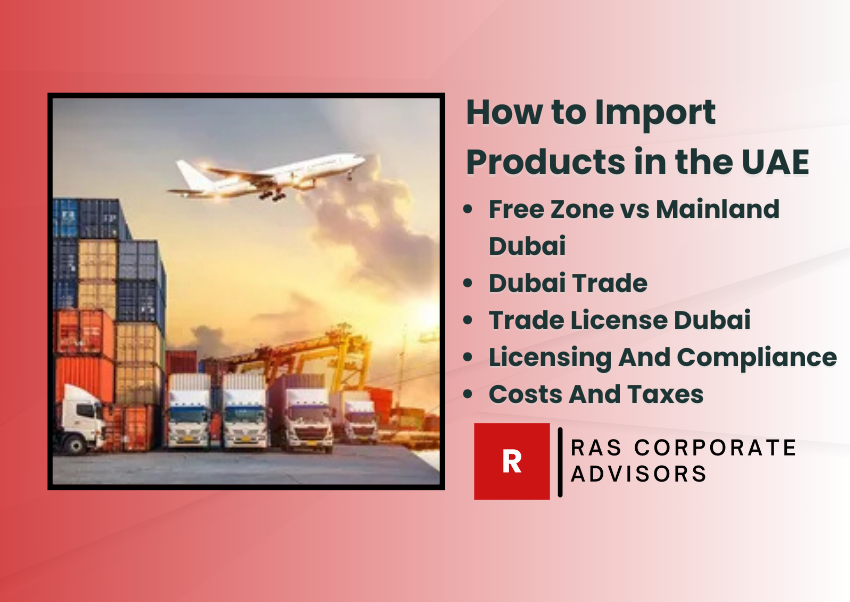How to Import Products in the UAE: Mainland vs Free Zone
How to Import Products in the UAE is a vital consideration for entrepreneurs looking to enter one of the world's most dynamic trade hubs. Whether you're bringing in electronics, textiles, industrial machinery, or food products, the UAE offers two main import pathways: a mainland vs. free zone setup.
Selecting a model has implications for obligations and compliance, customs duties, market entry, operational expenses, and taxation liabilities. Here, we simplify the processes, licensing, and fees so you can confidently navigate the import process.
Overview of Import Procedures in the UAE
The UAE operates under the GCC Common Customs Law, but each emirate has its own customs department, like Dubai Trade via the Mirsal 2 system or Abu Dhabi's ATLP platform. Businesses must obtain an importer code and the correct trade license and submit digital declarations.
Mainland imports clear goods directly into the UAE economy for unrestricted sales across the emirates.
Free zone imports allow goods to enter a duty-free zone for storage, assembly, or re-export. Selling into the mainland requires extra customs clearance.
Free Zone Benefits for Importers
Free zones focus on global trade and re-export. Advantages include:
-
100% foreign ownership
-
No customs duty for goods staying in the zone or re-exported
-
0–9% corporate tax rates on qualifying income
-
Proximity to ports and airports, e.g., JAFZA and DAFZA
Free zones suit global traders requiring warehouses, consolidation, or re-export facilities without directly targeting the UAE's domestic market.
Mainland Advantages for Traders
Mainland companies integrate directly with the UAE market:
-
Direct access to consumers, B2B clients, and government tenders
-
Sales permitted across all seven emirates
-
VAT refund eligibility on business expenses
This setup gives benefits to companies importing goods for retail, wholesale, or e-commerce inside the UAE.
License and compliance
-
Free zone license: Issued by the Zone Authority for specific activities (e.g., general trade, electronics).
-
Mainland license: Issued by the DED, listing import/trading activities.
-
Importer code: Needed for customs clearance; registered via zone customs or directly with emirate customs.
-
Special permits are required for regulated goods like food, medicines, or chemicals.
Importing into a Free Zone
-
Secure a free zone license and importer code.
-
Consign goods to the free zone.
-
Submit customs documents (invoice, packing list, bill of lading, permits).
-
File a "Transit In" declaration for duty-free entry.
-
Store goods in the zone or re-export.
-
Selling into the mainland requires a "Free Zone to Local" declaration and paying duty.
Importing into the Mainland
-
Obtain a mainland trade license in Dubai (or another emirate).
-
Register for an importer code with customs.
-
Submit entries via Mirsal 2, ATLP, or other portals.
-
Pay 5% customs duty plus VAT.
-
Clear goods within 24–48 hours (if compliant).
Costs and Taxes
-
Standard customs duty: 5% on CIF value.
-
VAT: 5% (reclaimable for VAT-registered businesses).
-
Excise duty: 50–100% for certain goods.
-
Free zone vs mainland Dubai cost structures differ—free zones defer duty until goods enter the mainland, while mainland imports pay upfront.
Efficiency and Port Infrastructure
The UAE's ports—Jebel Ali, Khalifa, and Sharjah—rank high in trading economics benchmarks for speed and automation. Digital systems like Mirsal 2 allow most shipments to clear in under 48 hours, barring inspections.
Selling Your Imported Goods
-
Mainland: Direct sale to local markets.
-
Free zone: Must sell to a mainland entity or pay duty for onshore distribution.
-
Many firms use a hybrid approach: free zone warehousing + mainland branch for retail sales.
Choosing the Right Emirate
-
Dubai: High costs but unmatched global connectivity and Dubai trade integration.
-
Abu Dhabi: Industrial focus with strong manufacturer incentives.
-
Sharjah: Budget-friendly warehousing and licensing.
-
Northern Emirates: Lower rental and licensing fees.
Partner with RAS Corporate Advisors for Hassle-Free Imports
At RAS Corporate Advisers, we simplify the entire import process so that you can focus on scaling your business. By securing your company setup - whether in a free zone or on the mainland – to get your trade license, customs duty, and importer code, we handle it with accuracy. Our team also helps with special product permits, accurate HS code classification, and skilled logistics or warehousing systems. With our expertise, your goods move quickly, your compliance remains on track, and your costs remain under control.
FAQs
1. What is the cheapest way to import in the UAE?
Using a cost-effective free area, such as Sharjah or the Northern Emirates, often reduces licensing and warehousing expenses.
2. Do I need a trade license for re-exports?
Yes. Even for re-export, you must have a valid license matching your activity.
3. Can a free zone company sell directly in the mainland?
Not without customs clearance and paying the applicable duty.
4. How long does import clearance take?
Usually, 24-48 hours if all documents are correct.
5. Are VAT refunds available for importers?
Yes, VAT-penked businesses can recover VAT on imports.
6. Which emirate is the best for importing goods?
Dubai provides top-level logistics, while Sharjah and the Northern Emirates are more centered.

